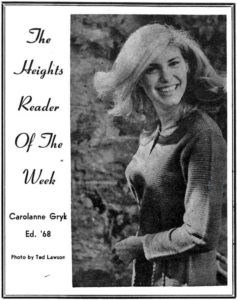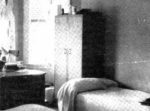The topic of women at BC 1964-68 probably deserves an entire blog itself. So this post touches on only a few elements.
Until 1989, For Boston, the BC fight song, contained the lyrics that are this post’s headline — “For here men are men . . . .” In May of that year, the BC Alumni Association Board of Directors recognized the presence of women in all schools at BC and approved changing those words to “For here all are one.” (They also made lyrics in the second stanza gender-neutral, but who knows that stanza? :) ) Women enrolled in Education (since 1952) and Nursing (since 1947) and certainly our female classmates for years sang a fight song that, one might say, ignored their existence. One might also say BC had had that problem for a while . . . and at least undervalued their presence during our years.
 One image of women students at BC is conveyed by the photo at right. The Heights, as enlightened as it perceived itself to be, regularly ran photos of, dare I say, “pretty girls” who were BC students. “The Heights Reader of the Week” was a page two staple for our freshman and sophomore years, at least. Sub Turri, for a number of years, had a “queen” each year and one could vote numerous times each year for the “queen” of this or that dance or event, e.g., Homecoming.
One image of women students at BC is conveyed by the photo at right. The Heights, as enlightened as it perceived itself to be, regularly ran photos of, dare I say, “pretty girls” who were BC students. “The Heights Reader of the Week” was a page two staple for our freshman and sophomore years, at least. Sub Turri, for a number of years, had a “queen” each year and one could vote numerous times each year for the “queen” of this or that dance or event, e.g., Homecoming.
This is not to say BC was so different from many other colleges at the time. Even public institutions and women’s colleges in the day had policies and regulations probably intended more to “protect” women than “empower” them.
Looking back, however, brings you to some things that today seem humorous, bizarre, or both.
Classmate Joanne Calore Turco recalls learning right off the bat, at orientation, that female students could not wear pants (or, gawd forbid, shorts!) on principal parts of the campus, among the academic buildings.
In October 1965, Bobbi McKuskie, ’69, became the “first girl to march with the BC band,” as she debuted at halftime of the BC-Penn State football game . . . not to play the trumpet or even the flute, but to twirl a baton. In March 1968, the Heights reported that the band had received approval to add three “lithe, lovely majorettes” to the band.
In 1965, Ann O’Malley, ’66, Education, served as co-editor-in-chief of The Heights and was the only woman to hold the top position, shared or otherwise, during our years. Janice Kolar was co-features editor in 1966 and “contributing editor” in 1967. No women were editors in 1968. Almost all of the members of the “business staff” were females, and all of the “typists.”
A “restaurant guide” in The Eagle’s (sic) Handbook for resident men offered this advice: “The economy-minded B.C. man with a hungry date will appreciate the Beacon Hill Kitchen, 23 Joy St., or The English Room, 29 Newbury St.”
The Resident Women’s Handbook for 1966-67 includes the following regulations and statements:
“Each student must make her bed each day before leaving the residence . . . .”
“The law requires that all dormitory shades be drawn as soon as the lights are put on.”
“A student may not sleep in any bed other than her own unless permission is given by her housemother, and more than one student may not sleep in a bed at any one time.” (!)
“If the student is more than an hour late and has not called her housemother, the latter will call the student’s parents, collect, to inform them of her absence.”
“When her residence is open, no student will be permitted to stay overnight in any hotel, motel, inn, guest house, or apartment within 25 miles of Boston unless she is with her parents or an approved chaperone.”
“Shorts and slacks are worn outside the residence only when they are appropriate attire for the student’s activities–as for picnics, the beach, etc.; and when leaving the residence in shorts or slacks, the student is expected to wear a knee-length coat.”
Male students had some interesting rules and regulations as well, but nothing really as onerous as some of those applied to women.
The women’s residences on South Street were apartment buildings, which BC even described as “not designed to serve as dormitories.” For several years, women complained of lack of privacy, no place to entertain guests, inadequate bathroom facilities, poor food, cold rooms, no recreation facilities, no televisions and no permission to bring one, and no options. The Heights in 1965 said, “It is surprising that BC, with all its beautiful new buildings on campus, can afford to let prospective students even see the women’s dorms.”
In February, 1966, The Heights provided an analysis of “. . . The Present Situation” involving housing for BC women. Written, not surprisingly, by a man. It is also, however, comprehensive and damning. The article was accompanied by a chart showing the differing curfews for resident women at local colleges. BC women, freshmen through senior years, had a 10:30 pm curfew Sundays-Thursdays. (A female classmate said that some cads actually had “late night” add-on dates, picked up after dropping off BC dates before 10:30.) On Fridays, curfews were midnight-1 am, depending on class year and semester. After first semester freshman year, when the curfew was midnight, Saturday curfews were 1 am.
No BC woman student was permitted to live in an off-campus apartment, even if she was over 21 and had permission from her parents.
In November 1967, there was a Sunday afternoon open house at each of the eight women’s dorms – Kirkwood, Linden, Pine, Radnor, Chestnut, South, Greycliffe, Alison. The event, the Heights reported, would “enable BC coeds to entertain guests in their rooms for the first time this year and to show visitors living conditions which many women believe are almost intolerable.”
And then there was the fact that no women could enroll in A&S or CBA. A petition to permit women in A&S, signed by 1,500 members of the campus community, was presented to the administration in March 1967. In September, 1967, The Heights reported “Fr. Walsh lists obstacles to women’s entrance in A&S.” Guess those were overcome somehow. Three years and a few months later, women were able to enroll in any and all of BC’s schools.
I had not been aware of this previously, but the female Bald Eagle is larger than the male. Today, the majority of students — both undergraduate and graduate in total and in all undergraduate schools except for the Carroll School of Management and Woods College (formerly the Evening School) — are women. And, while late starters compared to male students at BC, women now represent the majority of BC alumni.

